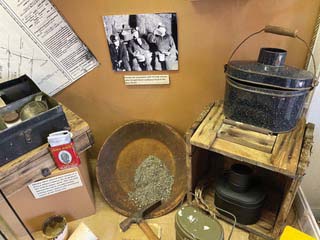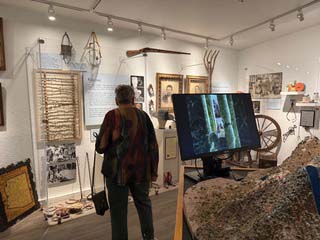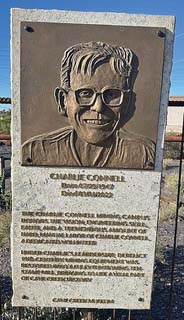Cave Creek Museum is featuring an exhibit that showcases lunch boxes throughout history.
Historical metal lunch boxes were used during the late 1800s mining days through 1940. According to JoAnn Stuckey, executive director for Cave Creek Museum, one of the most popular meals enjoyed by Arizona miners during that era was pasties.

“Pasties are associated with Cornish miners who brought their traditional food to the new world,” says Stuckey. “Pasties were hearty meals that had the appearance of a half pie. The pastry was folded over a mix of meat and vegetables then pressed to seal in the filling. Hardworking miners ate their meals, often in dark conditions, using carbide cap lights that attached to their hats.”
At the time, miners also frequently placed their claims in a Prince Albert tobacco time to protect their critical mining paperwork. The can and documents usually were tucked among rocks in the northeast corner of the claim site. This method of marking worked because of mutual respect and understanding.
Cave Creek Museum to wrap season
Cave Creek Museum will remain open through Saturday, May 31, 2025, the last day of its 2024-25 season.
“We opened the doors this season with a record number of visitors,” says JoAnn Stuckey, interim executive director.

Stuckey says the museum enjoyed many firsts throughout the season including record crowds for the new Arizona Gold Mining Experience and standing room only for its many Cave Creek Museum Presents and Kiwanis Family Fun Days series.
“I encourage Arizonans and visitors to bring friends and families to the museum before the end of May to see this year’s exhibits,” adds Stuckey. “Then, mark your calendar to return in October to see the changes that happened during the summer. However, during summer, there will be many tasks to accomplish calendar planning, fundraising, program decisions and mailings to say nothing of the exhibit changes that will take shape. We welcome people who would like to volunteer and be part of making positive changes for the museum. And, we look forward to another season of engagement with the community.”
The 54-year-old museum’s mission is to preserve the artifacts of the prehistory, history, culture and legacy of the Cave Creek Mining District and the Cave Creek/Carefree foothills area through education, research, and interpretive exhibits. The Cave Creek Museum is located at 6140 E. Skyline Drive in Cave Creek, Ariz., 480.488.2764. Open October through May.
Final stamp mill of the season run slated for May 10
Charlie Connell, Cave Creek Museum stamp mill expert, commemorated
The Cave Creek Museum recently dedicated its Golden Reef Stamp Mill and Tramway, the only operational stamp mill in the State of Arizona, to Charlie Connell. Connell, a mining engineer who discovered the 1870s stamp mill on top of Continental Mountain nearly a decade ago, worked with interested parties and talented volunteers to bring the stamp mill back to life – a five-year effort.

“When I first met Charlie, I remember his excitement about these giant metal hunks of metal and broken-down wooden pieces that had been donated to the museum on a donor’s property on the backside of the mountain in Cave Creek,” says Evelyn Johnson, former executive director of the museum.
Connell worked behind the scenes for about six months before the first boom and hauling trucks showed up at the museum early one March morning.
“His excitement was contagious as we loaded the first stamp mill pieces onto the truck,” adds Johnson. “Charlie and another gentleman said the Golden Reef Stamp Mill would be fully operational in five years. I looked at them and said either ‘I’m dreaming that I heard that or you’re dreaming it can be done.’ That’s how the current dream team got its name. I didn’t fully understand the depth of what a dream of a team they were until later. I learned so much while the restoration was taking place, and I know I asked the same questions 10 times. He never complained to me.”
Johnson says Connell came to her and asked if she could make socks for the stamp mill. She was given a pattern made from a file folder and some jeans. The first attempt was not completely successful, so she resorted to bringing a sewing machine to the museum and they worked together to get the perfect fit.
“Some of the endearing qualities I experienced while working with Charlie were patience, listening and caution with funds,” says Johnson. “He had the best nose for scavenging parts in the most unlikely places.”
As work began on the restoration, the museum volunteers needed to track hours spent on various tasks. During the first five years, more than 20,000 hours were logged. It was at the end of the first quarter of work on the stamp mill that Connell asked her if she wanted a copy of his activities report. She thought it would be about three pages; 39 pages later, she sat looking at the document overwhelmed by the detail. The stamp mill expert’s quarterly reports were all between 30 and 40 pages.
“Early on, Charlie and I talked about documenting the progress with pictures,” adds Johnson. “I still have about 2.000 photos. Charlie had 10,000-plus. Using his notes and pictures, I wish each of the institutions he worked with would publish a coffee table book with details about how to build a stamp mill.
Once, he even took his wife Kathy on a vacation to look at stamp mills in Australia.”
Once the Golden Reef Stamp Mill was partially operational, museum staff and the dream team figured out how to fundraise monies to repay museum coffers for restoration. The board of directors agreed to fully fund the efforts instead of waiting for funds to be raised before beginning restoration.
“After that, the first Miners’ Dinner came to life,” adds Johnson. “We wanted it to be a learning experience for attendees, so we took a field trip to a pastie shop in Mesa. I learned pasties were a Cornish miner’s meal. We served pasties to a crowd of 75 the first year. In 2024, we hosted the museum Miners’ Dinner to a capacity crowd of 156 people.
“We not only have the stamp mill, tramway, primary crusher, jaw crusher, amalgamation drum, mine tunnel and blacksmith shop, but also, we are actively training new millmen/persons,” say Johnson. “Charlie had a vision of what our mining campus could be, and I hope we will continue to train, improve, document and honor that vision.”
Connell had a unique ability to bring people together to get the job done and encourage them to stay involved. Throughout the restoration and operation stages, many people with unique talents joined the team; about 60 people have been involved during various stages of the project.

At the 2025 Miners’ Dinner, Connell’s wife was on hand as a bronze plaque of Connell was unveiled to commemorate his incredible work on behalf of the museum. It was installed on the mining campus close to the stamp mill. The Arizona Gold Mining Experience, which features Arizona’s only fully operational stamp mill, will makes its final run for the season on May 10, 2025.
Photos courtesy Cave Creek Museum





